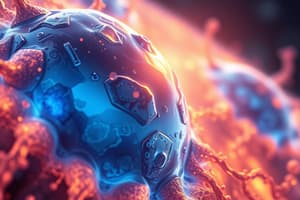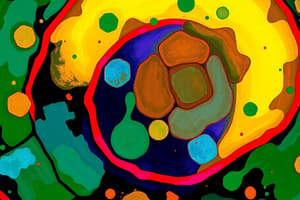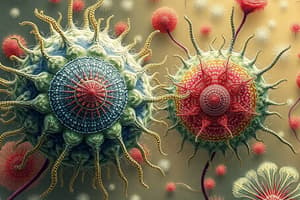Podcast
Questions and Answers
What characterizes the main types of stem cells?
What characterizes the main types of stem cells?
- Both types are totipotent and can develop into any cell type.
- Adult stem cells can become any cell type, while embryonic stem cells are limited.
- Embryonic stem cells are pluripotent while adult stem cells are multipotent. (correct)
- Adult stem cells are pluripotent while embryonic stem cells are multipotent.
Which transport mechanism requires energy from ATP?
Which transport mechanism requires energy from ATP?
- Osmosis
- Diffusion
- Facilitated diffusion
- Active transport (correct)
What role do checkpoints play in the cell cycle?
What role do checkpoints play in the cell cycle?
- They ensure that cellular damage is perpetuated.
- They allow for uncontrolled growth of cells.
- They ensure proper division and prevent uncontrolled growth. (correct)
- They solely focus on the differentiation of stem cells.
What is the term for the adaptation in cells where they increase in size?
What is the term for the adaptation in cells where they increase in size?
Which of the following statements about cell types is correct?
Which of the following statements about cell types is correct?
How many phases make up the interphase of the cell cycle?
How many phases make up the interphase of the cell cycle?
What is the primary function of the Golgi Apparatus in a cell?
What is the primary function of the Golgi Apparatus in a cell?
In which stage of mitosis do chromosomes align at the cell's equator?
In which stage of mitosis do chromosomes align at the cell's equator?
Which process involves the conversion of light energy into chemical energy?
Which process involves the conversion of light energy into chemical energy?
What role do lysosomes play in cellular function?
What role do lysosomes play in cellular function?
Flashcards are hidden until you start studying
Study Notes
Cell Biology
1. Basic Unit of Life
- Cells are the fundamental units of structure and function in living organisms.
- Two main types of cells: prokaryotic (no nucleus, e.g., bacteria) and eukaryotic (nucleus present, e.g., plant and animal cells).
2. Cell Structure
- Cell Membrane: Semi-permeable barrier that controls the movement of substances in and out of the cell.
- Cytoplasm: Gel-like substance within the cell membrane, housing organelles.
- Nucleus: Contains genetic material (DNA) and controls cellular activities.
- Organelles:
- Mitochondria: Powerhouse of the cell, site of ATP production.
- Ribosomes: Sites of protein synthesis.
- Endoplasmic Reticulum (ER):
- Rough ER: Studded with ribosomes, synthesizes proteins.
- Smooth ER: Synthesizes lipids and detoxifies substances.
- Golgi Apparatus: Modifies, sorts, and packages proteins and lipids for secretion or use within the cell.
- Lysosomes: Contain digestive enzymes to break down waste materials and cellular debris.
- Chloroplasts: Present in plant cells, site of photosynthesis.
3. Cell Division
- Mitosis: Process by which a eukaryotic cell divides to produce two identical daughter cells.
- Stages: Prophase, Metaphase, Anaphase, Telophase, and Cytokinesis.
- Meiosis: Specialized cell division that produces gametes (sperm and eggs), resulting in four genetically unique cells.
4. Cellular Processes
- Cellular Respiration: Process of converting glucose and oxygen into energy (ATP), carbon dioxide, and water.
- Photosynthesis: Process by which green plants convert light energy into chemical energy, producing glucose and oxygen from carbon dioxide and water.
5. Cell Communication
- Cells communicate through signaling molecules (hormones, neurotransmitters).
- Types of signaling:
- Autocrine: Cell signals to itself.
- Paracrine: Cell signals to nearby cells.
- Endocrine: Signals travel through the bloodstream to distant cells.
6. Cell Cycle Regulation
- The cell cycle consists of interphase (G1, S, G2) and mitotic phase (M).
- Checkpoints ensure proper division and prevent uncontrolled growth (tumors).
7. Stem Cells
- Undifferentiated cells with the potential to develop into various cell types.
- Types:
- Embryonic Stem Cells: Pluripotent (can become any cell type).
- Adult Stem Cells: Multipotent (limited to specific cell types).
8. Cellular Transport Mechanisms
- Passive Transport: Movement of substances across a cell membrane without energy (e.g., diffusion, osmosis).
- Active Transport: Movement of substances against their concentration gradient using energy (ATP).
9. Cellular Adaptations
- Cells can adapt to changes in their environment (e.g., hypertrophy, atrophy, hyperplasia) to maintain homeostasis.
Summary
Cell biology is the study of the structure and function of cells. Understanding the various components and processes of cells is essential for grasping broader biological concepts and the functionality of living organisms.
Basic Unit of Life
- Cells serve as the basic structural and functional units of all living organisms.
- Two primary cell types:
- Prokaryotic cells lack a nucleus and include bacteria.
- Eukaryotic cells have a nucleus and include plant and animal cells.
Cell Structure
- Cell Membrane: A semi-permeable barrier that regulates substance movement in and out of cells.
- Cytoplasm: A gel-like substance that fills the cell and contains organelles.
- Nucleus: Houses genetic material (DNA) and oversees cellular functions.
- Organelles:
- Mitochondria: Known as the cell's powerhouse, responsible for ATP production.
- Ribosomes: The sites where protein synthesis occurs.
- Endoplasmic Reticulum (ER):
- Rough ER: Associated with ribosomes; synthesizes proteins.
- Smooth ER: Involved in lipid synthesis and detoxification processes.
- Golgi Apparatus: Modifies, sorts, and packages proteins and lipids for transport.
- Lysosomes: Contain digestive enzymes to decompose waste and cellular debris.
- Chloroplasts: Found in plant cells where photosynthesis takes place.
Cell Division
- Mitosis: Eukaryotic process yielding two identical daughter cells, occurring in stages: Prophase, Metaphase, Anaphase, Telophase, and Cytokinesis.
- Meiosis: Specialized division generating four genetically unique gametes (sperm and eggs).
Cellular Processes
- Cellular Respiration: Converts glucose and oxygen into energy (ATP), while releasing carbon dioxide and water as byproducts.
- Photosynthesis: Green plants transform light energy into chemical energy, producing glucose and oxygen from carbon dioxide and water.
Cell Communication
- Cells utilize signaling molecules for communication, including hormones and neurotransmitters.
- Types of signaling:
- Autocrine: Cells signal themselves.
- Paracrine: Cells signal adjacent cells.
- Endocrine: Signals are carried through the bloodstream to distant cells.
Cell Cycle Regulation
- The cell cycle comprises interphase (G1, S, G2) and the mitotic phase (M).
- Checkpoints are crucial to ensure accurate cell division and prevent tumor development.
Stem Cells
- Undifferentiated cells possessing the capability to differentiate into various cell types.
- Categories include:
- Embryonic Stem Cells: Pluripotent, capable of becoming any cell type.
- Adult Stem Cells: Multipotent, limited to forming specific cell types.
Cellular Transport Mechanisms
- Passive Transport: Movement of substances across membranes without energy, including diffusion and osmosis.
- Active Transport: Requires energy (ATP) to move substances against their concentration gradient.
Cellular Adaptations
- Cells adapt to environmental changes for homeostasis, exhibiting conditions such as hypertrophy (increase in size), atrophy (decrease in size), and hyperplasia (increase in number).
Summary
- Cell biology explores cellular structure and function, providing insights into broader biological concepts and organism functionality.
Studying That Suits You
Use AI to generate personalized quizzes and flashcards to suit your learning preferences.





